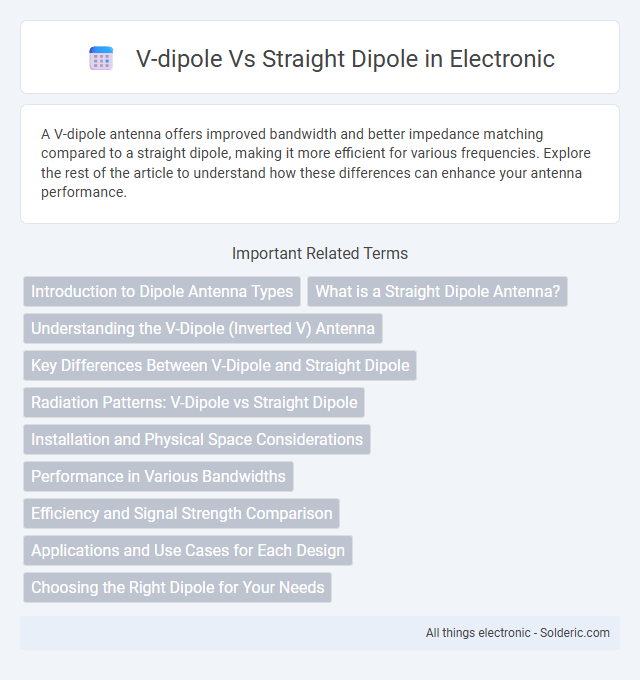A V-dipole antenna offers improved bandwidth and better impedance matching compared to a straight dipole, making it more efficient for various frequencies. Explore the rest of the article to understand how these differences can enhance your antenna performance.
Comparison Table
| Feature | V-Dipole Antenna | Straight Dipole Antenna |
|---|---|---|
| Structure | Two elements angled in a V shape | Two collinear straight elements |
| Radiation Pattern | Broader, more directional with slight gain | Omnidirectional in the horizontal plane |
| Impedance | Typically around 50-75 ohms | Approximately 72 ohms |
| Bandwidth | Narrow to moderate bandwidth | Moderate bandwidth |
| Polarization | Linear, usually horizontal or vertical | Linear, horizontal most common |
| Application | Directional communication, gain enhancement | General purpose, easy installation |
| Installation Complexity | Requires precise angle setup | Simple and straightforward |
| Typical Usage Frequency | HF and VHF bands | HF, VHF, and higher bands |
Introduction to Dipole Antenna Types
Dipole antennas, fundamental in wireless communication, primarily include V-dipole and straight dipole configurations, each offering unique radiation patterns and impedance characteristics. V-dipoles, with arms angled typically between 90 to 120 degrees, provide broader bandwidth and reduced antenna height compared to straight dipoles, which maintain a linear, collinear structure for simpler design and consistent resonance. The selection between these dipole types depends on application requirements such as frequency range, physical space constraints, and desired radiation coverage.
What is a Straight Dipole Antenna?
A straight dipole antenna consists of two equal-length conductive elements arranged in a straight line, typically fed at the center, making it one of the simplest and most widely used antenna types for radio frequency transmission and reception. This antenna offers a predictable radiation pattern with maximum gain perpendicular to the elements, providing efficient communication over medium distances. You can easily optimize a straight dipole antenna for specific frequencies by adjusting the element length to half the wavelength of the target signal.
Understanding the V-Dipole (Inverted V) Antenna
The V-dipole, or inverted V antenna, features two arms angled downward, creating a shape resembling the letter V, which improves impedance matching and broadens the radiation pattern compared to a straight dipole. This design reduces the antenna's overall height requirements, making it suitable for limited space installations while maintaining effective transmission and reception capabilities across HF bands. The inverted V's radiation pattern tends to be more omnidirectional horizontally, offering better performance for multi-directional communication.
Key Differences Between V-Dipole and Straight Dipole
The V-dipole antenna features arms arranged in a V shape, offering wider bandwidth and improved radiation pattern compared to the straight dipole, which has linear arms aligned in a single axis. You benefit from enhanced directional gain and reduced antenna length with a V-dipole, while a straight dipole provides simpler design and omnidirectional characteristics. Key differences include antenna geometry, impedance bandwidth, and radiation efficiency, impacting performance in various communication applications.
Radiation Patterns: V-Dipole vs Straight Dipole
The V-dipole antenna exhibits a broader radiation pattern with increased horizontal beamwidth compared to the straight dipole, enhancing signal coverage in wider azimuthal angles. In contrast, the straight dipole produces a more focused bidirectional pattern with pronounced nulls at the ends, resulting in higher gain along the broadside but limited angular coverage. These differences make the V-dipole favorable for applications requiring wider coverage, while the straight dipole suits scenarios demanding concentrated signal strength.
Installation and Physical Space Considerations
A V-dipole antenna requires less horizontal space compared to a straight dipole, making it ideal for installations in constrained areas or where mounting options are limited. Its angled arms reduce the overall footprint, allowing for easier placement around obstacles or structures. You can optimize your antenna layout by choosing a V-dipole when available installation space is tight, ensuring efficient performance without extensive physical modifications.
Performance in Various Bandwidths
V-dipoles offer improved impedance matching and wider bandwidth performance compared to straight dipoles, making them suitable for multi-band and broadband applications. The angled arms of a V-dipole create a lower Q factor, resulting in a smoother SWR response across frequencies. Straight dipoles tend to have narrower optimal bandwidths, which may require additional tuning or matching components for efficient operation outside their resonant frequency.
Efficiency and Signal Strength Comparison
V-dipole antennas typically offer improved efficiency and stronger signal strength compared to straight dipoles due to their wider radiation pattern and better impedance matching. The angled arms in a V-dipole reduce signal loss and provide more gain in desired directions, enhancing overall communication performance. If you need optimal signal reception and transmission, choosing a V-dipole can significantly improve your antenna system's effectiveness.
Applications and Use Cases for Each Design
The V-dipole antenna is preferred in applications requiring broader bandwidth and improved impedance matching, making it ideal for HF and VHF communications, including amateur radio and broadcasting. Straight dipole antennas are widely used in simpler setups such as fixed base stations, field testing, and basic RF experiments due to their straightforward design and predictable radiation pattern. Each design supports specific use cases where the V-dipole excels in multi-frequency adaptability while the straight dipole offers ease of deployment and cost-effectiveness.
Choosing the Right Dipole for Your Needs
When selecting between a V-dipole and a straight dipole, consider factors such as space constraints and radiation pattern requirements; a V-dipole offers a more compact installation with a broader elevation angle, ideal for limited spaces and multipath environments. Straight dipoles typically provide a more focused and higher gain along the axis, making them suitable for long-distance, directional communication. Your choice should align with your antenna placement, desired coverage, and signal propagation characteristics to maximize performance.
V-dipole vs straight dipole Infographic

 solderic.com
solderic.com